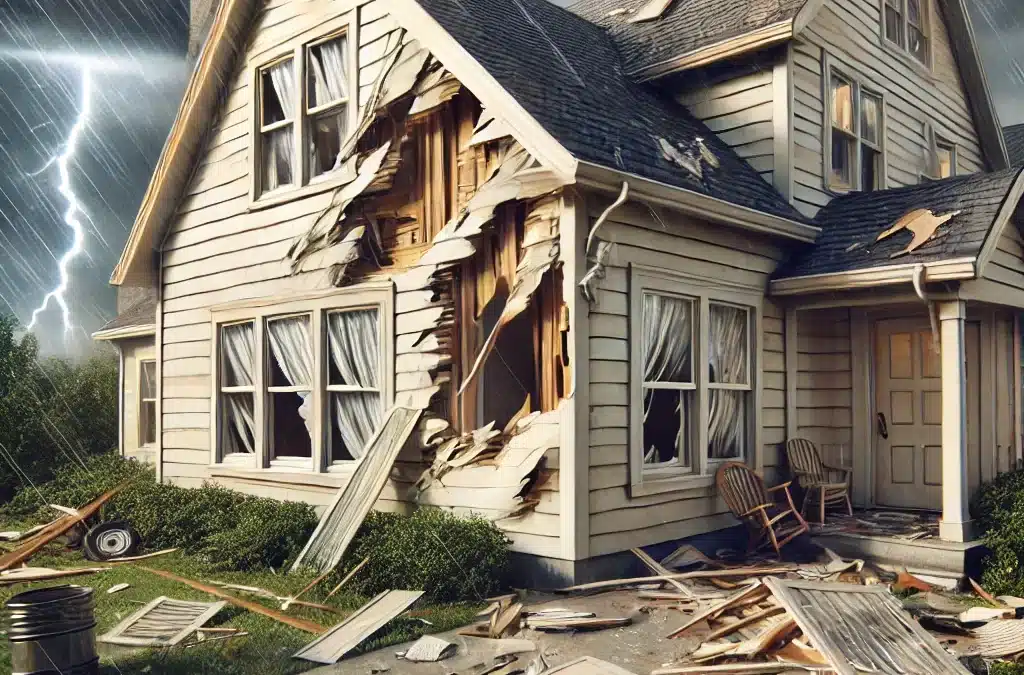Storms in Des Moines, Iowa, can be fierce. From high winds to hail and heavy snow, your home’s roof and siding often take the brunt of nature’s wrath. At Superior Siding and Window Systems, we’ve helped countless homeowners recover after storms caused everything from minor dents to severe structural damage.
Whether it’s a summer thunderstorm or a winter ice storm, storm damage can be overwhelming. But knowing what steps to take—and in what order—can make all the difference in protecting your home and saving money on repairs. This guide will walk you through what to do if your roof or siding gets damaged in a storm, including tips on documenting damage, working with your insurance company, and scheduling expert repairs.
Assessing the Damage
1. Prioritize Safety
After the storm passes, ensure your family is safe. Stay away from downed power lines, avoid walking on a potentially damaged roof, and watch for loose siding panels that could fall.
2. Inspect Your Home Exterior from the Ground
Walk around your home and take note of visible damage:
- Roof: Look for missing shingles, dents, or sagging areas. Check if gutters are detached or clogged with debris.
- Siding: Look for cracks, holes, or pieces that have blown off. Hail often leaves noticeable dents or chips.
- Windows: Inspect for broken glass or damaged frames.
If it’s safe, take photos or videos of the damage. This documentation will be critical for insurance claims.
Types of Storm Damage to Watch For in Des Moines
High Winds
Des Moines frequently experiences severe storms with winds exceeding 60 mph. These winds can tear shingles off your roof or loosen siding panels. In June 2020, a derecho with wind gusts over 100 mph caused widespread destruction across Iowa, including homes losing entire sections of siding and roofing.
Hail Damage
Hailstones the size of golf balls—or larger—can dent metal siding, crack vinyl, and leave pockmarks on roofs. In 2017, Des Moines saw a hailstorm that caused over $2 billion in damage, one of the most destructive in Iowa’s history.
Ice and Snow
Winter storms bring ice dams, heavy snow loads, and freezing rain that can damage roofs and siding. Frozen gutters can exacerbate problems, leading to water infiltration.
Take Immediate Action
1. Temporary Repairs
If possible, make temporary fixes to prevent further damage:
- Cover holes in siding with waterproof tape or a heavy-duty tarp.
- Use a roof tarp to cover missing shingles or leaks.
- Clear debris from gutters to allow water to drain properly.
2. Call a Professional for Inspection
Don’t attempt to climb on your roof or fix large issues yourself—it’s dangerous, especially after a storm. Call experts like Superior Siding and Window Systems to assess the damage safely and thoroughly.
3. Document Everything
Take close-up photos of damaged areas before making any repairs. This documentation will be invaluable when filing an insurance claim.
Filing an Insurance Claim
1. Review Your Policy
Check your homeowner’s insurance policy to understand what storm damage is covered. Most policies cover wind and hail damage but may have exclusions or deductibles for certain types of damage.
2. Contact Your Insurance Company
Report the damage as soon as possible. Provide photos, videos, and a detailed list of issues. Keep notes of conversations with your insurance representative, including names and dates.
3. Get an Estimate from a Trusted Contractor
While insurance companies may send an adjuster, it’s wise to have your own contractor provide a professional estimate. Superior Siding and Window Systems offers detailed assessments to ensure nothing is overlooked.
Repairing Storm Damage
1. Work with a Local, Trusted Contractor
Storm damage often attracts out-of-town contractors (sometimes called “storm chasers”) who promise quick fixes but lack local expertise or long-term accountability. Choose a reliable local company like Superior Siding and Window Systems.
2. Prioritize Repairs
Some repairs, like fixing leaks or damaged siding, should be done immediately to prevent further issues. Other upgrades, such as replacing gutters or repainting siding, can be scheduled later.
3. Upgrade for Better Protection
Consider replacing damaged materials with higher-quality options. For example:
- Impact-resistant shingles can withstand hail better than standard asphalt shingles.
- Fiber cement siding is more durable than vinyl in high-wind areas.
How to Prevent Future Storm Damage
- Inspect Your Roof and Siding Annually: Regular maintenance helps identify vulnerabilities before storms strike.
- Trim Overhanging Branches: Prevent branches from damaging your home during high winds or ice storms.
- Invest in Storm-Resistant Materials: Superior can help you choose siding and roofing options designed to withstand Iowa’s unpredictable weather.
Real-Life Success Stories
At Superior, we’ve helped Des Moines homeowners recover from countless storms. After the 2020 derecho, one family in Ankeny contacted us when their vinyl siding was torn off, and their roof was leaking. Our team replaced their siding with durable fiber cement and installed impact-resistant shingles, ensuring their home was better prepared for future storms.
Another customer in West Des Moines came to us after a hailstorm left dents across their aluminum siding. We quickly replaced the siding and helped them navigate the insurance process, turning a stressful situation into a seamless experience.
Final Thoughts
Storm damage can be daunting, but with the right steps, you can protect your home and recover quickly. From assessing damage to navigating insurance claims and completing quality repairs, Superior Siding and Window Systems is here to help every step of the way.
Don’t wait until the next storm hits—schedule a free inspection with our team today and ensure your home is storm-ready!

